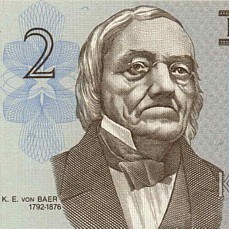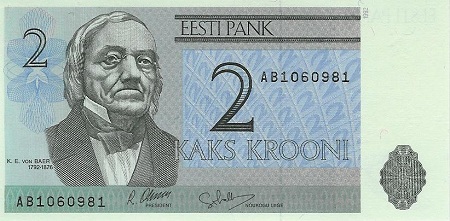ESTONIA
Karl Ernst Von Baer

Karl Ernst Von Baer was born in Piibe Manor, within the Koeru Parish of Jarvamaa County in Estonia. He was one of ten children of noble parents who were first cousins. He spent his first seven years in the care of an aunt and uncle, where he apparently gained his interest in biology. He went to school in Tallinn and in 1810 he attended the National University of Tartu (Dorpat), obtaining his medical degree in 1814. Between 1814 -1817 he left Estonia to continue his education in Berlin, Wurzburg and Vienna. During this time, one of his professors, Ignatz Dollinger, a noted physiologist, introduced Karl Von Baer to the field of embryology, a field of science concerned with the development of fertilized eggs.
He studied the embryonic development in animals, and discovered the Blastosphere, an early stage of embryonic development, and the Notochord, a flexible rod shaped ‘backbone’ in embryos. He accepted a position at Konigsberg University in 1817. In 1820 he married Auguste von Medem of Konigsberg, and eventually had six children. By 1826 he had also become the professor of zoology and anatomy as well. In this year he also discovered the mammalian ovum, and reported that mammals, including humans, develop from eggs in 1827.
He taught in St Petersburg in 1829 and eventually joined the St. Petersburg Academy of Sciences in Zoology, anatomy and physiology. While in St. Petersburg, Baer participated in the field of Craniology and accumulated a rather large skull collection. From 1830-1840 he contributed considerable research in a study of arctic meteorology and as a result, Baer (Bera) Island was named for him in the Kara Sea, north of Siberia. While studying the arctic weather in Siberia he established the field of Geocryology as a formal scientific field. During this time he also led an expedition to Novaya Zemlya, the northern section of the Ural Mountains extending into the Arctic Sea, where he collected natural specimens of the area. He was the first president of the Russian Geographical Society and the Russian Entomological Society, which he helped to establish. During his time in Russia, he devoted much of his studies to Geology and established Baer’s Law that states that as a result of Earth’s rotation, the erosion of rivers in the northern hemisphere will occur mainly on the right banks, while in the southern hemisphere, the erosion will occur mainly on the left banks.
During 1851-1853, he studied the northern coast of Estonia and Lake Peipsi along the Estonian border with Russia, focusing on the fisheries and their effects on the fish population. Then, from 1853-1856 he led similar expeditions to the Caspian Sea and the Volga River, looking into their fishing practices. As a result of his work there, Russia adopted their first law for conservation and in 1859 established fishing regulations in the area.
He spent his retirement years from 1867-1876 in Tartu, actively voicing his disapproval of Charles Darwin’s theories. While he believed that some species might be related to each other, he rejected the idea that all species derived from a common ancestor. His studies also included Entomology (the study of insects) and subjective biology, focusing on different perceptions of time experienced by various organisms. Baer travelled extensively in his time, travelling through the European continent, including Russia, the Caspian Sea, The North Cape of Norway and the Lapland in Finland.
Karl Von Baer died in November 1876 and is buried in Tartu. He is honored by having his home from 1867-1876 being a museum, with a statue in Tartu and since 1992 with his portrait on the 2 Krooni banknote.

